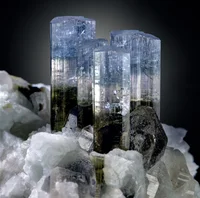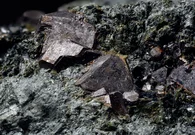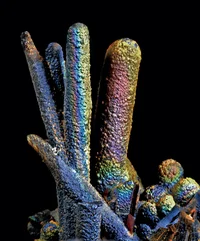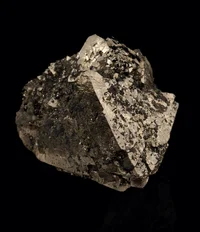Abstract 2025
Rivista Mineralogica Italiana > Abstract Articoli
Abstract ITALIAN MINERALOGICAL MAGAZINE nr. 1-2025 | ||||||
TOURMALINE FROM ELBA ISLAND:
MORPHOLOGY, COLOURS, AND INTERNAL STRUCTURES  | The study of
tourmaline specimens from the Elba Island was performed using thin sections
prepared cutting the crystal along or orthogonal to the elongation axis. This
method allowed the identification of a variety of characteristic patterns
formed by sectors showing different forms and colours. Indeed, tourmalines can
record chemical-physical changes of the crystallization environment, through
the selective incorporation of transitions elements that give rise to different
colours. Thin sections (down to 10 μm thick) of tourmaline crystals have been
prepared to examine these chromatic variations. In this paper the main textural
features observed in tourmalines from the pegmatites of Elba Island are
described and are illustrated. These observations give important insights about
the internal textures of the crystals as well as about the growth mechanisms of
tourmalines, allowing the description of several different kinds of phenomena
(e.g., skeletal growth, dissolution, graphic intergrowths). | |||||
The long-lasting mining activity performed on the Elba
Island allowed the finding of world-class mineralogical specimens of hematite,
pyrite and ilvaite. These minerals have been widely described in several
scientific and amateur papers. Other Elban minerals, despite their scientific
or aesthetic interest, have not had this privilege. This paper aims to describe
one of these minerals, goethite. The most valuable specimens of this ferric
iron oxy-hydroxide are those consisting of mammillary or globular aggregates
within cavities of “limonite”. The localities that have provided the best
specimens of Elban goethite are the Rosseto, Piè d’Ammone and Pozzofondi stopes
in the Rio Marina mine, the Fornacelle mining site in Rio Albano, and Capo
d’Arco. The most spectacular findings in terms of size and quality are those of
the Piè d’Ammone site. Here, large cavities were found covered with shiny and
iridescent mammillary goethite, sometimes containing aesthetic aggregates of
numerous and thin stalactites, parallel to each other, internally hollow and
with a constant section known as “organ
pipe goethite”.
This article reports a further finding of goethite performed in
September 1973 at the Vallone Basso stope, Capo Calamita mine, Elba Island
(LI). In these specimens, goethite crystallized on pre-existing prismatic
crystals of gypsum grown on limonite; gypsum was later dissolved, leaving a
hole within the goethite coatings. The cavity where these samples were found
was partially covered by divergent or irregular, columnar goethite aggregates.
Some specimens showed the classic mammillary aggregates characterized by
several colours, sometimes iridescent or with a metallic luster. The broken
columnar aggregates show a central hole having a regular pseudo-hexagonal shape
due to the section of the monoclinic prisms that characterized the gypsum
crystals. Rarely, the occurrence of gypsum relicts was observed. The most
beautiful and sought-after samples were those with beautiful iridescence. The
colours can change from steel grey to blue grey, to light blue and brown,
although the surfaces were often covered with powdery ochraceous material.
During the 1970s and 1980s these specimens gained a deserved fame for their
aesthetic value and large size. Currently, only a limited number of specimens
is still preserved in mineral collections owing to their extreme fragility. | ||||||
PYRITE FROM RIO MARINA (ELBA ISLAND): UNUSUAL FINDINGS FROM THE VIGNERIA STOPE | Well-crystallized samples of pyrite from the Rio
Marina mine are among the classic Italian mineral specimens. However, little is
known about the specimens collected in the Vigneria stope, where pyrite was
found in some unusual occurrences. Currently, this locality is no longer
productive, and a residential complex and a parking area have been built in its
place. Vigneria was the oldest mining site of the Rio Marina ore deposit, and
it was abandoned at the beginning of the 1970s. An interesting finding was performed
by two local mineral collectors, Anna Antola and Mario Muti, at the end of the
1980s. Some works exposed a lens of magnetite with scattered pyritohedral
crystals of pyrite up to 3 cm in size.
This finding agrees with the historical descriptions
given by Federico Millosevich (1875-1942) based on the specimens of the Roster
collection kept in the Museum of Florence.
The Vigneria stope was known also for the occurrence
of cubic and octahedral pyrite crystals. On the contrary, complex habits were
not found. At the beginning of the 1980s, iron-cross’ twins of pyrite, up to 5
cm, were collected in clayey dumps of the +11.75 m tunnel. Moreover, close to
the beach, some masses of hematite+clay minerals, visible only in certain
conditions related to the tide level, hosted shiny octahedral pyrite crystals,
up to 6 cm in size, that were collected by the two same mineral collectors
cited above.
This habit was the same described by Millosevich and
commonly found during the 1880s. Finally, other pyrite specimens, with equant
cubic individuals, have been found in clays exposed during some construction
works near the Palazzo dei Riccetti, close to the Rio Marina village. | |||||
COBALTITE, NATIVE GOLD AND BISMUTH TELLURIDES. AN EXCEPTIONAL MINERAL ASSEMBLAGE FROM THE GINEVRO MINE (ELBA ISLAND, TUSCANY, ITALY)  | Eastern Elba is well known for the exceptional
specimens of hematite, pyrite, and ilvaite. However, mineralogical research has
allowed the discovery of several mineral species and, among them, three new
minerals: minguzzite and bonattite, discovered in the 1950s from the Capo
Calamita mine, and riomarinaite, first reported in 2005 from Rio Marina.
Several other species, interesting from a systematic perspective, have been
described from these localities. During the 1990s, three of the authors of this
paper (F.S., M.H. and P.R.) began an investigation about the occurrence of
cobaltite in the ore deposits from Eastern Elba, discovering the presence of
this cobalt sulfoarsenide in several localities, i.e. Punta della Calamita mine
and Capo d’Arco mine. A further finding was performed at the Ginevro mine. In
this locality mineralogical sampling has allowed the discovery of an
exceptional assemblage of Co-Bi-Te-Au phases, first found in the open pit at
the +14 level. Further specimens were collected in the old dumps and in the
underground workings (+6 and -24 levels).
In the studied assemblage, cobaltite is the most
common mineral. It occurs as pseudo-cube-octahedral crystals, up to 5 mm,
embedded in the skarn. Chemical data shows variable Ni and Fe contents (up to
0.26 and 0.17 atoms per formula unit, respectively) and S/As ratios slightly
higher than 1. The presence of cobaltite is usually highlighted by pink-lilac
efflorescence of erythrite, usually formed by globular aggregates of
micrometer-sized tabular crystals. Cobaltite is often associated with
bismuthinite, in lead-grey aggregates, up to 5 mm in length, and a member of
the safflorite-löllingite series, rarely observed in lamellar crystals up to 3
mm. Once, cosalite was identified in this association. The most interesting
feature of this cobaltite mineralization is the relatively widespread
occurrence of Te minerals. Currently, the presence of at least four different
species has been observed: ingodite, joséite, pilsenite, and ehrigite. Ingodite
occurs as silvery flakes closely associated with cobaltite and bismuthinite. It
has been identified through X-ray diffraction and WDS chemical analysis,
pointing to the formula Bi1.92Te0.98S1.10.
Minerals related to joséite have been reported on the
basis of EDS chemical analysis, suggesting the occurrence of joséite-B, and
X-ray powder diffraction, agreeing with the presence of joséite-A. This latter
mineral forms a 5 mm mass composed of micaceous crystals, black in color. Other
two Te species whose presence is hypothesized on the basis of EDS data only are
pilsenite and ehrigite. In the studied samples there are also two native
elements: bismuth and gold.
The former is
relatively widespread as very small grains, less than 0.05 mm in size,
associated with cobaltite, gold, and Bi tellurides. Gold has been identified as
micrometer-sized grains associated with cobaltite. Chemical data shows minor
contents of Ag and Fe. Finally, a gold-bismuth sulfide, whose chemistry
corresponds to that of jonassonite, was identified in sample collected in the
old dumps as very tiny grains. | |||||
Abstract ITALIAN MINERALOGICAL MAGAZINE nr. 2-2025 | ||||||
Abstract ITALIAN MINERALOGICAL MAGAZINE nr. 3-2025 | ||||||
Abstract ITALIAN MINERALOGICAL MAGAZINE nr. 4-2025 | ||||||



